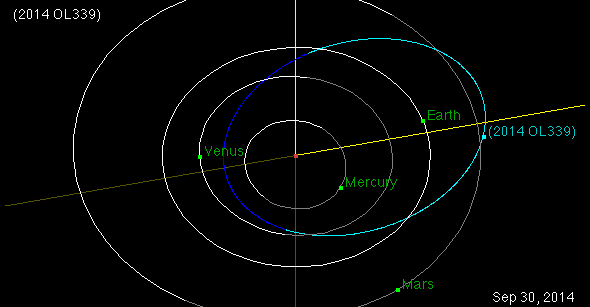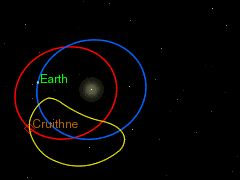Quick: How many moons does the Earth have?
You might be forgiven for saying “one,” but it turns out the question isn’t all that easy to answer … because it depends on what you mean by “moon.”
Of course, we have one moon, the one we call the Moon. It physically orbits the Earth, so it counts. In this case, what we firmly call a moon would orbit inside what’s called the planet’s Hill sphere, a region around the planet where the planet’s gravity dominates over everything else.
But there are other orbits that make it look like an object is orbiting the Earth, but it doesn’t really. There are subtly different flavors of objects like these, but one kind orbits the Sun in elliptical orbits, with an orbital size and shape just right that they take almost (but not quite) exactly one year to go around the Sun once. Typically their orbits are elliptical, taking them closer in and farther out from the Sun than the Earth.
This is precisely the case with 2014 OL339, a 150-meter (or so) diameter rock discovered serendipitously in July by a team of asteroid hunters. Its orbit is highly elliptical; it crosses the orbit of Venus and gets out as far as Mars. It’s also slightly tilted compared with the Earth’s orbit by about 10°.

Diagram by NASA/JPL-Caltech
However, the numbers work out such that it takes—get this—364.92 days to circle the Sun once. Sound familiar? That’s only a few hours less than the Earth’s orbital period (one year, of course). When two objects orbit with periods very close to the same number (or simple multiples, like one taking exactly twice as long as the other) we say they are in resonant orbits.
OL339 is in such a resonant orbit. Mind you, all by its lonesome it just orbits the Sun on an ellipse like a gazillion other such rocks; remove the Earth and it’ll orbit pretty much as it does now (that’s another reason we say it’s not a proper moon of the Earth). But, because of the complex way motions add together, from Earth, OL339 looks like it orbits us, moving backwards relative to the stars (and, I suppose I have to note, it has essentially no chance of ever impacting Earth).

Diagram by Jacowa, via wikipedia
In fact, its motion in space looks more like a kidney bean because of this, as shown in the graphic here. In this case the animation shows the path of the weird asteroid Cruithne, which is another object that mimics being a moon. They don’t always stay in orbits like these; over time the gravitational poking by the Earth can alter their orbits, and eventually they wind up moving away from Earth. OL339 should be Earth’s quasi-satellite for about a thousand years in total; it’s been around for centuries already, and may not stick around for more than about 165 more years.
I know, this is confusing, but it turns out objects like these are important. Some start as objects that were in longer, less attached kidney-bean orbits that then tightened up over time. Others started as Trojan objects; sharing Earth’s exact orbit but ahead or behind it by 60°. Some were just passing by but can, over time, wind up temporarily becoming quasi-satellites as their orbits change ever so slightly due to Earth’s gravity.
What I find particularly interesting about these objects is that due to these weird resonances, they don’t necessarily move very rapidly relative to the Earth. Most asteroids whiz by us at dozens of kilometers per second, but these quasi-moons don’t move nearly so rapidly. That means they would make good targets for exploration; changing the velocity of a rocket takes a lot of fuel, so going to an object that isn’t moving as quickly is easier (and leaves more available mass for instruments or, hopefully, people).
Who knows? We have 165 years or so to visit OL339 before it moves off, which should be plenty of time. And there are others, too; three true quasi-satellites (called (164207) 2004 GU9, (277810) 2006 FV35 and 2013 LX28) and a handful more with slightly farther flung orbits (like Cruithne). In some cases, asteroids like this are easier to reach even than the Moon! I do want us to go back to the Moon, and to push on to Mars … but visiting these rocks may prove to be an excellent intermediate step. I’d love to see us doing something like that in the next few years.
Tip o’ the dew shield to New Scientist.